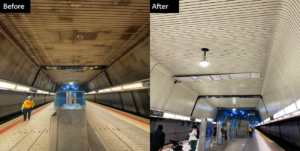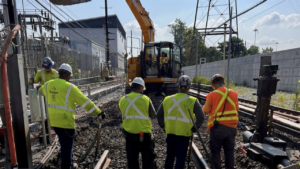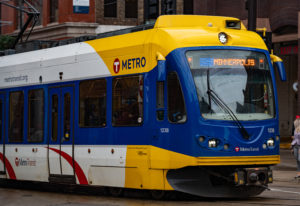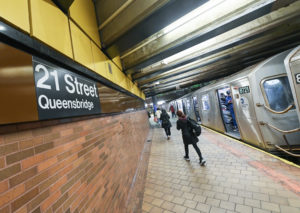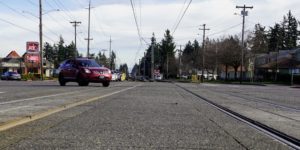Transit maintenance takes preparation, collaboration
Written by Mischa Wanek-Libman, editor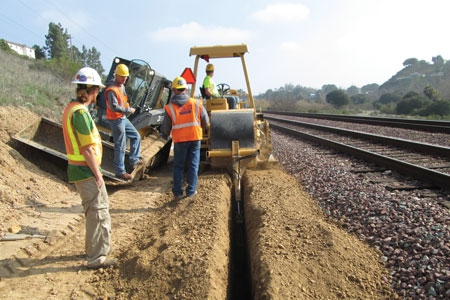
NCTD knows the indispensability of a good plan and of being a good partner.
{besps}February14_challenge{/besps} {besps_c}0|1lubrication.jpg| Crews digging for fiber optic cable needed for PTC installation.{/besps_c} {besps_c}0|2lubrication.jpg| Rail maintenance being performed at night.{/besps_c} {besps_c}0|3lubrication.jpg| Bridge work being performed near Marine Corps Base Camp Pendleton.{/besps_c} {besps_c}0|4lubrication.jpg| One side of the SANDAG-managed construction projects that enhances NCTD’s system was the completion of the new double-track Santa Margarita rail bridge that was opened for service Nov. 18, 2013.{/besps_c}
NCTD knows the indispensability of a good plan and of being a good partner.
The North County Transit District (NCTD) is responsible for moving more than 12 million riders a year around north San Diego County on its various modes of transportation, which include COASTER commuter rail, SPRINTER light-rail service and BREEZE bus service.
In addition to planning and maintaining passenger rail service on two lines, NCTD must liaise with eight municipalities in its service area, the San Diego Metropolitan Transit System (San Diego MTS), the San Diego Association of Governments (SANDAG), as well as freight and other passenger rail service providers.
To those unfamiliar, NCTD’s operational parameters may come across as confusing: NCTD co-owns with San Diego MTS the coastal railroad that hosts COASTER, Metrolink, Amtrak and BNSF traffic and NCTD has the lead role for implementing transit operations, routine capital projects and state of good repair projects, while SANDAG, the San Diego region’s planning organization, is responsible for development and construction activities related to capacity enhancing projects. All of this results in making NCTD a case study in well- executed collaboration.
Maintenance planning
Nick Freeman, deputy chief operations officer, Rail Operations at NCTD, says the district’s rail maintenance planning consists of two parts: regular routine maintenance and capital enhancement projects.
“Our regular routine maintenance is determined by Federal Railroad Administration regulations, territory specific maintenance plans, and track inspections. It is then scheduled and prioritized by the MOW manager and entered into a database for record keeping, which our contractor, TransitAmerica Services, Inc., (TASI) is responsible for maintaining,” said Freeman. “The replacement of rail assets is scheduled according to different factors, such as useful life expectancy of an asset, the current condition of the rail and the increase in million gross tons on the rail. All of which is done on a five-year ‘look-ahead’ and scheduled accordingly. NCTD staff members work closely together with TASI throughout the entire maintenance planning process.”
In Fiscal Year 2014, NCTD has a capital budget of $31 million and $14 million is budgeted for rail operations and maintenance. NCTD currently has $9.7 million approved for maintenance-of-way projects that include crossing renewal, crosstie renewal, grinding, rail replacement, drai0nage improvements, turnout renewal and bridge work. NCTD estimates its bridge repair and replacement needs will increase to around $4.3 million beginning in Fiscal Year 2016.
“NCTD maintains over 60 bridge structures within its coastal and inland rail corridors. The bridges within the inland corridors are newer and require far less maintenance since the rail line was improved to support the SPRINTER light-rail service in 2008. In general, the coastal bridges are older and require additional maintenance and inspection,” said Peykan Abassi, chief development officer at the agency. “The yearly bridge inspections help the district to prioritize and allocate resources. The district strives to replace bridges that near their design life and rehabilitate bridges with accelerated deterioration.”
As far as more general challenges are concerned, NCTD runs into a familiar obstacle in the transit industry: obtaining work windows.
“The reason for this is simple; NCTD has an obligation to provide a reliable, on-time service to its customers, both passengers and freight. NCTD is in the process of upgrading its infrastructure to provide enhanced service that will provide customers with an even more reliable on-time performance. The challenge of obtaining a work window is tough, but not impossible,” explained Freeman. “Project managers submit work plans to a diverse committee that includes representatives from multiple departments within NCTD. That begins the review and comment period, which will clarify the work to be performed. Follow up meetings may be scheduled depending on the complexity of the project. Finally, schedules are checked and the AWW may then be scheduled.”
NCTD is also advancing its positive train control (PTC) work to meet the mandate’s 2015 deadline. The district has budgeted $87.3 million, consisting of federal, state and local funds, for the project.
The project will be completed in two phases, the first phase, system development, which included field surveys, mapping, radio propagation and spectrum studies, system design and development work was completed in July 2012. A Notice to Proceed has been given to NCTD’s contractor for Phase 2 – Procurement/Installation/Testing. The agency says Phase 2 is 43-percent complete and NCTD is on schedule to meet the implementation deadline.
Maintenance partnering
The second part of NCTD’s rail capital program includes the projects SANDAG is responsible for managing. Currently, SANDAG has 16 capital projects under
development or under construction and has completed six additional projects along the rail corridor between Orange County and Santa Fe Depot in San Diego at an estimated program cost of $998 million, of which $467 million has been identified.
“Since SANDAG began the double-tracking program in late 2009, completed projects have added five miles of double-track to the corridor in San Diego County. There are four major capital projects under construction, which will add over seven miles of double-track, replace existing bridges and upgrade signal systems. The completed and in-progress projects will increase the percentage of the corridor that is double-tracked from 51 percent to 66 percent,” said Abassi. “Additionally, there are 12 projects in planning and design that will add over 12 miles of additional double-track and replace over 30 aging bridges. In addition to adding capacity, these projects provide operational flexibility, reduce future maintenance costs and enhance safety and reliability of the overall system.”
Another aspect of maintenance partnering is being a good neighbor and NCTD does this by first, focusing on keeping its employees and the community safe and second, developing successful community outreach efforts.
Frances Schnall, NCTD marketing representative says the district follows FRA regulations when it comes to its roadway worker protection program and also has an extensive rail safety outreach program focusing on certain “hotspots” where safety issues are more prevalent. Additionally, NCTD is in the beginning stages of creating a series of safety videos to educate its passengers about safety, security and emergency response procedures.
When it comes to reaching out to the public concerning project impact, Schnall says, “[NCTD and SANDAG] proactively engage the general public to inform them of aparticular project’s regional benefits, which may include increasing train capacity, reducing environmental impacts or creating sustainable transit options.”
Schnall notes the district’s efforts in working with the community have been enhanced by the practice of embedding outreach staff in the project teams.
“The close coordination of maintenance and engineering staff with outreach staff benefits our customers and neighbors by ensuring that they receive the most current and accurate information,” said Schnall. “Being a good neighbor to local residents and businesses near the railroad is important to NCTD. Maintenance and construction projects may have temporary impacts and NCTD has an active notification program for affected communities. We work with residents, businesses and our city partners to reduce those impacts as much as possible and to ensure neighbors are aware of impacts that could affect their daily (and nightly) routines.”

